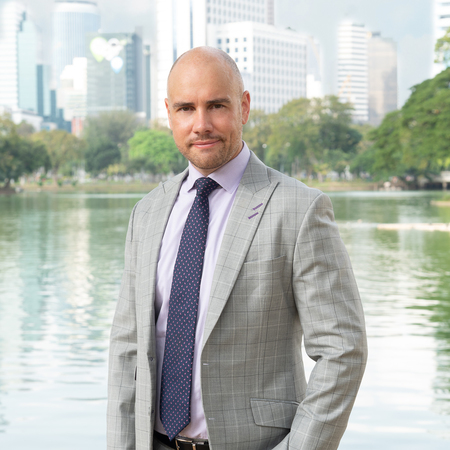Businesses often rely on the driving force of an excellent leader, and when the time comes for the new to replace the old, business owners should consider the impact if that missing piece is not effectively replaced. This is where succession planning comes into play, as companies consider strategies for a smooth transition to a new generation of leadership.
Approximately 80% of all businesses in Thailand are family owned and run, with a staggering combined net worth of close to 30 trillion THB. Yet Thai companies have a mixed track record when it comes to succession planning; many neglect to formulate a clear strategy, often acknowledging the importance of this step but still failing to carry it out.
In a 2019 survey, 29% of business leaders stated that they had an enter-exit strategy in place, 32% said a family constitution or protocol had been decided upon, and 57% claimed they had an established succession plan. Where a formal plan is absent, transitions are more likely to turn messy, as disagreement tends to bubble over between family members as well as others in the inner circle.
Such outcomes can do great damage to the company, and to the legacy of its owner after their retirement. The good news, however, is that more companies are recognising the importance of succession planning. Among MNCs in Thailand, the appointment of internal candidates has risen from 55% to 85% over the last five years.
It is worth understanding how these companies approach succession planning – and in particular, which qualities they look for in the next generation of leaders.
Key considerations
MNCs face several choices when developing their replacement strategy:
1. Choosing between internal or external candidates
Internal candidates are the preferred choice, as they are a known quantity and already embedded in the culture. This familiarity allows for a smoother and safer transition, with fewer obstacles in the way of progress. Internally sourced successors are also more likely to serve the company for a longer term, as they have already seen the position up close before taking it.
The picture may be further complicated by other factors, however. In practice, some MNCs only allow fresh external recruits to fill specific roles, while other positions are reserved for existing employees to grow into.
Some of our clients ask us to gather information on local and expat talent – either to evaluate directly, or to compare with their own internal candidate pool. Moreover, internal talent isn’t always available; fast-growing companies often do not have the time to develop potential successors.
2. Hiring local or externally
For businesses in Thailand that look for successors outside their own family, a new question arises about where the ideal candidate will come from. Most companies prefer to hire locally to save on cost, but this savings often brings its own challenges: Local candidates are not always proficient in key areas such as technology, globalisation, and automation. Without these skills, local talent will find it hard to effectively transition into a forward-looking leadership role.
Sometimes, a balance can be struck between local and foreign talent. Over the past decade, many future Thai leaders have pursued foreign education and employment – and then returned home with a higher knowledge base. With a high-quality education and experience in international business, they may be ideal for leading companies forward into a new, data-driven era of business success.
When MNCs in Thailand cannot find a local candidate, they tend to opt for an ASEAN-based one. Yet there are still other factors to consider, as the chosen successor will eventually become the new face of the company.
3. Factoring in diversity and values
With Thai business leaders commonly entering retirement at age 55 – 60, and with many industries still dominated by men, many MNCs are pushing for a 50/50 gender balance in their upper echelons. Equal consideration for men and women is frequently made part of their succession plans, with at least 2 female candidates needing to be shortlisted before any decisions can be made.
Very often, this push for equality leads companies to hire female leaders who are a near-perfect fit for the position, even if male candidates that perfectly fit the role are also available. Kimberly-Clark, Nestlé, and P&G are among the many businesses that have standardised this approach, in an effort to promote qualified female leaders across the global value chain.
P&G Thailand, for example, has its Sales Manager, Plant Manager, and Managing Director positions held by women. The company’s proactive approach to diversity means that it sets up targets, which are then monitored and used to maintain their Diversity & Inclusion agenda, with gender pay regulated by the Compensation & Leadership Development Committee.
On these metrics, Thailand outperforms many other countries – but there is still work to be done. In Thailand, 26% of businesses have women in managerial roles, as opposed to 22% across Asia-Pacific. Thai businesses also have the highest percentage of employed family members that are women (31%, compared to only 19% in Asia-Pacific).
Thai women often pursue higher education, and Thai culture is comparatively welcoming for female leaders in a business setting. However, statistics show that women contribute to only a small percentage of senior roles in Asia-Pacific as a whole. In 37% of organisations across the region, 5 or fewer of the top 100 management positions are held by a woman. Just 14% of organisations have at least 30% of their leadership roles filled by women.
Taking the first steps
Succession planning is about making the right selection, and preparing both the candidate and the company to work well with each other. Looking internally is ideal, but it is not always easy to find such a person who is also skilled at applying modern technology to business strategy and management. In some cases, it may be worth casting the net wider in order to find the person with the right background, whose presence would best fit the company’s values and cultural aspirations.
In my experience, businesses often overlook the potential to transition supply chain leaders into general management roles. Qualified people at these positions can maximise their skills with proper executive training and exposure. In all cases, however, the right perspective can give today’s leaders a clearer view of the path forward – so that effective succession planning occurs before it is needed, rather than after it is too late.
For succession planning or other recruitment needs, Connexus can help. Contact us today to learn more.










